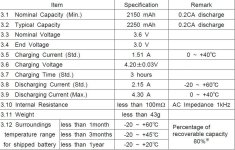1v is way out of balance, as measured on one 4.2v cell group. .1v repeat, .1v out of balance is still out of balance, but tolerable if your are not discharging 100%. .05v should be tolerable, provided it does not continue to drift farther than that. So if your cell groups when fully charged are half of them at 4.15v, and the others at 4.18v, this is typical for a "balanced" bike battery when fully charged. All of them at 4.2v exactly would be great, but in the real world, cells don't act like that for all that long. After use, sometimes even when new, a few cells will charge faster, causing the bms to stop the charge. So those cells at 4.15v never quite got 100% full, or they did, and then when stopped at 4.2v, they discharged just a bit because even new, they simply only hold 4.15v. This isn't the test lab, your pack has some great cells in it, and some that are only average. But if all your cells are at 4.15 or more when charged, its all good. Good enough to ride, and use the battery for years.
But,,, I'm not sure what you are seeing. Are you able to check the voltage of each group of cells? Some batteries make the bms and its plug inaccessible.
3v of sag under a 5 amps load is a lot, but alas, typical of cheap ass cell packs. Sounds like you may have one. Its just a lot of load for cheap cells.
You say your pack is 4p. 4p of what? Typical laptop cells found in really cheap batteries can handle about .5c of discharge rate. Lets say your cells hold 2 ah each. that would mean 8 ah of size. a .5c discharge rate of that pack would be 4 amps. So if your cells are that type, you would be seeing a lot of sag at 5 amps, and be killing them at 10 amps.
We may also be talking about two different things. Voltage sag is the voltage drop when load is applied.
But as you ride, the voltage will drop as you ride. This is not sag, its just discharging it. The more you ride, the lower the pack voltage goes,, and,, it still sags under load. At some point, sag alone can shut off the pack before its absolutely empty.. Sag tends to get worse as you get into the last 10% of the charge. So the lower your voltage when stopped gets, the less amps you can give it, especially at the very end.


